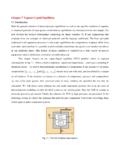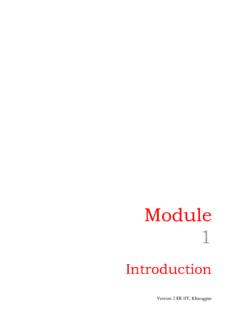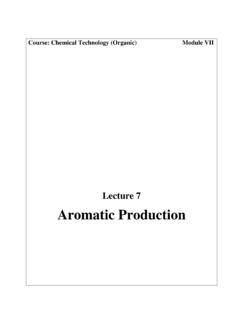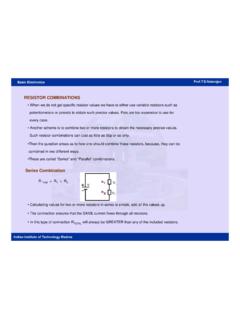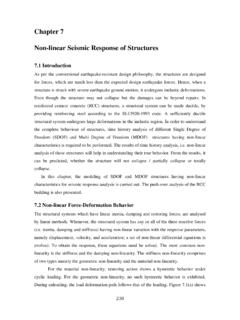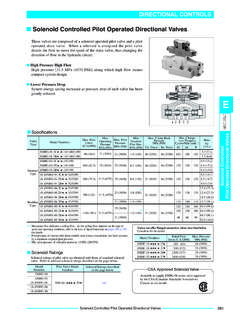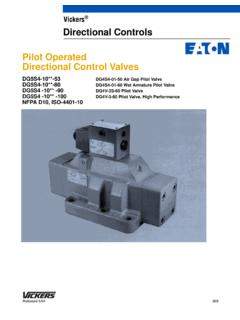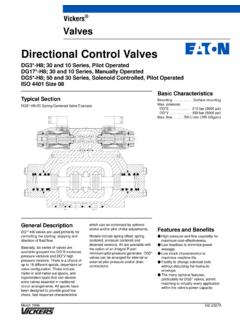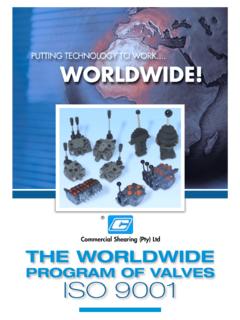Transcription of DIRECTIONAL CONTROL VALVES - NPTEL
1 Learning Objectives Lecture 15 DIRECTIONAL CONTROL VALVES Upon completion of this chapter, the student should be able to: List different types of VALVES used in fluid power. Explain various classifications of DIRECTIONAL CONTROL VALVES . Describe the working and construction of various direction CONTROL VALVES . Identify the graphic symbols for various types of direction CONTROL VALVES . Explain the different applications of direction CONTROL VALVES . Explain the working principle of solenoid -actuated VALVES . Define valve overlap. Evaluate the performance of hydraulic systems using direction CONTROL VALVES .
2 One of the most important considerations in any fluid power system is CONTROL . If CONTROL components are not properly selected, the entire system does not function as required. In fluid power, controlling elements are called VALVES . There are three types of VALVES : 1. DIRECTIONAL CONTROL VALVES (DCVs): They determine the path through which a fluid transverses a given circuit. Pressure CONTROL VALVES : They protect the system against overpressure, which may occur due to a sudden surge as VALVES open or close or due to an increase in fluid demand. 2. Flow CONTROL VALVES : Shock absorbers are hydraulic devices designed to smooth out pressure surges and to dampen hydraulic shock.
3 In addition, the fluid flow rate must be controlled in various lines of a hydraulic circuit. For example, the CONTROL of actuator speeds can be accomplished through use of flow CONTROL VALVES . Non-compensated flow CONTROL VALVES are used where precise speed CONTROL is not required because the flow rate varies with pressure drop across a flow CONTROL valve. It is important to know the primary function and operation of various types of CONTROL components not only for good functioning of a system, but also for discovering innovative methods to improve the fluid power system for a given application. CONTROL VALVES A valve is a device that receives an external signal (mechanical, fluid pilot signal, electrical or electronics) to release, stop or redirect the fluid that flows through it.
4 The function of a DCV is to CONTROL the direction of fluid flow in any hydraulic system. A DCV does this by changing the position of internal movable parts. To be more specific, a DCV is mainly required for the following purposes: To start, stop, accelerate, decelerate and change the direction of motion of a hydraulic actuator. To permit the free flow from the pump to the reservoir at low pressure when the pump s delivery is not needed into the system. To vent the relief valve by either electrical or mechanical CONTROL . To isolate certain branch of a circuit. 2 Any valve contains ports that are external openings through which a fluid can enter and exit via connecting pipelines.
5 The number of ports on a DCV is identified using the term way. Thus, a valve with four ports is a four-way valve A DCV consists of a valve body or valve housing and a valve mechanism usually mounted on a sub-plate. The ports of a sub-plate are threaded to hold the tube fittings which connect the valve to the fluid conductor lines. The valve mechanism directs the fluid to selected output ports or stops the fluid from passing through the valve. DCVs can be classified based on fluid path, design characteristics, CONTROL methods and construction. Classification of DCVs based Fluid Path Based on fluid path, DCVs can be classified as follows: Check VALVES .
6 Shuttle VALVES . Two-way VALVES . Three-way VALVES . Four-way VALVES . Classification of DCVs based on Design Characteristics Based on design characteristics, DCVs can be classified as follows: An internal valve mechanism that directs the flow of fluid. Such a mechanism can either be a poppet, a ball, a sliding spool, a rotary plug or a rotary disk. Number of switching positions (usually 2 or 3). Number of connecting ports or ways. Method of valve actuation that causes the valve mechanism to move into an alternate position. Classification of DCVs based on the CONTROL Method Based on the CONTROL method, DCVs can be classified as follows: Direct controlled DCV:A valve is actuated directly on the valve spool.
7 This is suitable for small-sized VALVES . Indirect controlled DCV:A valve is actuated by a pilot line or using a solenoid or by the combination of electrohydraulic and electro-pneumatic means. The use of solenoid reduces the size of the valve. This is suitable for large-sized VALVES . Classification of DCVs based on the Construction of Internal Moving Parts Based on the construction of internal moving parts, DCVs can be classified as follows: Rotary spool type: In this type, the spool is rotated to change the direction of fluid. It has longitudinal grooves. The rotary spools are usually manually operated . Sliding spool type: This consists of a specially shaped spool and a means of positioning the spool.
8 The spool is fitted with precision into the body bore through the longitudinal axis of the valve body. The lands of the spool divide this bore into a series of separate chambers. The ports of the valve body lead into these chambers and the position of the spool determines the nature of inter-connection between the ports. Table 3/2 way valve : 3ports and 2 position DCV Table 1. Each different switching position is shown by a square. 2. Flow directions are indicated by arrows. 3. Blocked ports are shown by horizontal lines. 4. Ports are shown in an appropriate flow direction with line arrows The switching position, flow direction, and port for different configurations is represented in Table Two-way, three-way, four-way and five-way representation is shown in Table Devices Direction CONTROL VALVES may be actuated by a variety of methods.
9 Actuation is the method of moving the valve element from one position to another. There are four basic methods of actuation: Manual, mechanical, solenoid - operated and pilot- operated . Several combinations of actuation are possible using these four basic methods. Graphical symbols of such combinations are given in Table Manually operated : In manually operated DCVs, the spool is shifted manually by moving a handle pushing a button or stepping on a foot pedal. When the handle is not operated , the spool returns to its original position by means of a spring. Mechanically operated : The spool is shifted by mechanical linkages such as cam and rollers.
10 solenoid operated : When an electric coil or a solenoid is energized, it creates a magnetic force that pulls the armature into the coil. This causes the armature to push the spool of the valve. Pilot operated : A DCV can also be shifted by applying a pilot signal (either hydraulic or pneumatic) against a piston at either end of the valve spool. When pilot pressure is introduced, it pushes the piston to shift the spool. 7 solenoid operated Pilot operated Manual operated Push button Foot operated Pilot- operated solenoid Two-position detent Spring return Check Valve The simplest DCV is a check valve.
